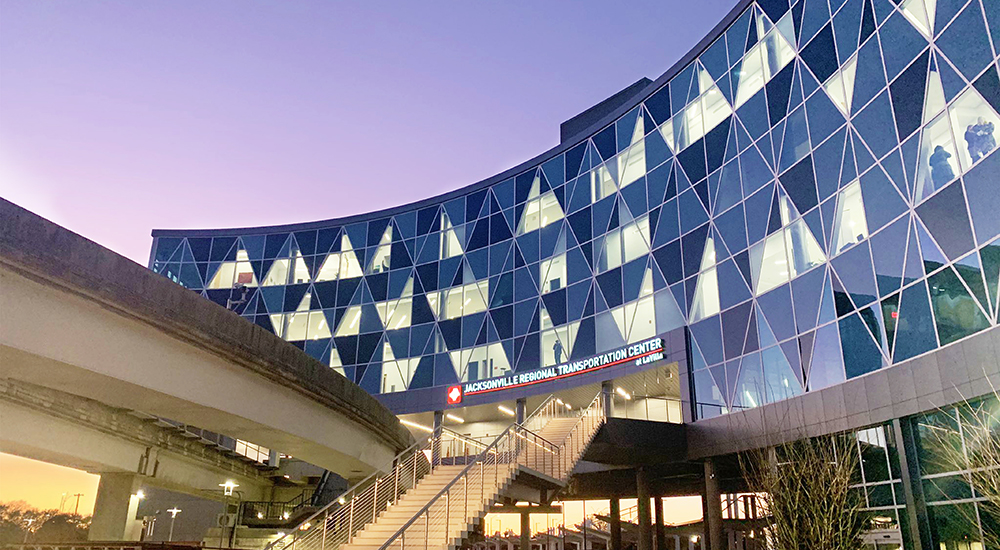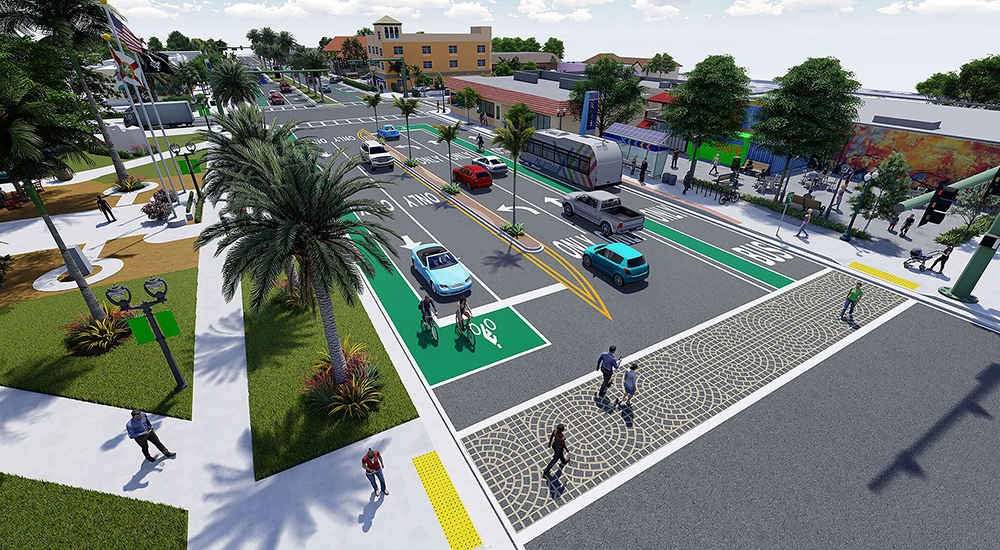Michael Baker’s iconic New River Gorge Bridge helped transform a West Virginia mountain region
From the Fall 2017 issue of Signature
Benjy Simpson beams like a kid, even at age 69, as he approaches the giant New River Gorge Bridge atop these steep Appalachian Mountains in the heart of Fayette County, W.Va. Despite knee problems borne of years of mountain climbing, rappelling, whitewater rafting and jumping out of airplanes, this outdoorsman-turned-businessman hardly can wait to lead yet another group of visitors across a catwalk just below the deck of his beloved arch bridge.
At the center of the bridge’s iconic steel arch, 1,515 feet across the catwalk, Simpson points down to a convoy of river rafters bucking in the world-class rapids that rip through the gorge some 851 feet below – far enough down to make some bridge walkers gasp, grip the hand rails even more tightly and cautiously measure the distance to the other side.
Simpson, a West Virginia transplant, runs a popular business next to the bridge called Bridge Walk, which has been providing guided catwalk tours of the bridge since his company opened in 2010 in a partnership with the West Virginia Department of Transportation and the National Park Service. As perhaps the bridge’s biggest ambassador, Simpson seems to know every detail of the bridge and its history: its corrosion-resistant steel beams, made by U.S.X. Corp. and constructed by its subsidiary, American Bridge; the fact that inspectors can climb inside those beams; the unique expansion rockers where vertical beams meet the arch; the number of ironworkers who built the bridge; and even the spot where the Oprah Winfrey Show once had a woman rappel off the bridge to conquer her fear of heights. He has framed pictures to back him up.
In many ways, Simpson serves as the honorary keeper of the bridge, resident historian, and, as he sometimes refers to himself when watching out for mischief, the Bridge Troll. And his countless bridge tales captivate his visitors, like the time a paraplegic man BASE-jumped off the bridge with a parachute – in his wheelchair – during a recent Bridge Day festival. Or how kids used to sneak up on the bridge’s arch during construction in the 1970s and jump off, into a safety net below.
“It was a rite of passage,” he says of the illegal antics, shaking his head.
But there’s one fact about this bridge – memorialized on a U.S. quarter, postage stamp and countless tourist collectibles – which Simpson can’t seem to wait to remind his patrons, and he declares it with a sense of genuine reverence and admiration: The New River Gorge Bridge was designed by Michael Baker International.
“I have a passion for this bridge,” Simpson readily admits. “Not too many people love it like I do.”
A DESTINATION BRIDGE
Who could blame Simpson, though? As this entire region of West Virginia comes together to celebrate this now-historic bridge’s 40th anniversary, we can pause for a moment, not just to contemplate the initial impact of designing an architectural wonder that connected two mountains and their small communities, as this bridge did. Or the fact that this four-lane bridge and highway reduced the travel time, mountain to mountain, from 45 minutes down and up a barely two-lane, switch-back road – especially for big trucks – to less than a minute.
“The history of West Virginia can largely be written by its inaccessibility and isolation versus opening the door” with the bridge, says David Perry, a local resident and former state delegate who used to haul steel via truck to the bridge site and whose father, a local pastor, gave the invocation on the day the ironworkers brought the two halves of the steel arch together on the bridge. “It has changed the fabric of the state.”
Instead, let’s consider the fact that this bridge at once captured the world’s attention and opened up a highway corridor streamlining travel from Toronto, Canada, all the way down to Miami. At the same time, the bridge has created a rather profound Appalachian gateway and steel-framed destination for tourists and outdoor enthusiasts from around the world, all looking to explore unique habitat and the region’s coal history, rappel down the side of a mountain, or take on the world-class white-water rapids of the New River Gorge and Gauley River. Or just see the bridge.
“Of the 7,244 bridges in the state of West Virginia, this is the crown jewel,” says Jim Wriston, chief transportation engineer for the West Virginia Department of Transportation’s Division of Highways and in-house local bridge expert, as he calls himself. Wriston grew up nearby, he says, and watched the construction process in the 1970s as he admittedly participated in his own “rite of passage” on occasion with his friends.
Still, he credits the bridge with influencing his decision to become a civil engineer and work for the state. Walking out onto the catwalk with his visitors recently, he shares Simpson’s youthful enthusiasm for the bridge, even with his two shirt-pocket protectors full of pens and his trademark untied necktie.
“This is the bridge,” he proclaims.
A BRIDGE TO ECONOMIC OPPORTUNITY
Meanwhile, the bridge has opened up new opportunities for the National Park Service, outdoor adventure outfits, resorts, music festival producers and the agriculture sector, as well as for communities such as Lansing on the north side of the bridge and Fayetteville, Oak Hill and even Beckley on the south side. And all of this continues to evolve and grow even 40 years later.
Officials there have been reminding the world every fall of the bridge’s impact on the region with its annual Bridge Day celebration, which, with the exception of 2001, when the U.S. Department of Homeland Security urged officials to cancel the festival, continues to draw thousands of people annually and is said to bring into the local economy more than a million dollars in one weekend.
“These are the kinds of opportunities we live for – not only to design great works of infrastructure, but also to make the communities we serve safer, more accessible, more sustainable and more prosperous,” says Brian A. Lutes, CEO of Michael Baker. “The New River Gorge Bridge exemplifies our number-one tenet as a company, that ‘We Make a Difference.’ This bridge has a prominent place in the Michael Baker legacy.”
CROSSING THE GORGE
Talk of a bridge over the gorge began as early as 1963, when U.S. President John F. Kennedy directed his Appalachian Regional Commission to come up with a comprehensive economic development plan for the region. Its top priority: developing a modern highway system that would better connect the state. That eventually would include Corridor L, a 70-mile stretch of road that would connect I-79 near Sutton, W.Va., to I-77 in Beckley, W.Va. The commission’s biggest challenge: a short stretch of road that would somehow have to cross over the New River Gorge.
In 1967, the West Virginia State Road Commission hired Michael Baker to design an 11-mile stretch of the highway in Fayette County – including a bridge over the gorge.
According to an application submitted to the National Register of Historic Places by the National Park Service, Michael Baker engineers worked the equivalent of 15 years' worth of full-time man hours to design the bridge and made more than 4,000 hand calculations. What they designed was a bridge that, at the time, would be the longest steel-arch bridge in the world and one that later would attract imitators and competitors.
“From an engineering and construction viewpoint, this bridge will be truly a most significant undertaking,” according to then-Governor Arch Moore, as reported in The Baker Engineer in 1977. “But, even more importantly, the construction and completion of this project will contribute greatly to the economy of the state in general and the Fayetteville area in particular.” And it did.
ACCESS TO AN ECOSYSTEM
National Park Service officials would be the first to acknowledge the economic benefits of the bridge over the years. Today, the park service oversees an estimated 100 miles of wild rivers in the region, as well as federally protected land around the rivers, including several old, abandoned coal towns. It also maintains a bustling and historically robust visitor center and viewing decks along the north rim of the gorge, right next to the bridge and only about 100 yards from the entrance to Bridge Walk.
Today, the National Park Service employs 120 people to manage this recreation area, including 75 permanent positions. The region attracts more than a million visitors annually.
"This bridge has opened the whole area to north and south traffic and created an incredible economic opportunity,” says Lizzie Watts, a National Park superintendent who oversees the New River Gorge region. “There are incredible resources in the New River area, ecosystem-wise. It has one of the highest diversities of plants, including rare and endangered plants, warm-water fisheries, great hiking, boating, biking and birds.
“And,” she adds, “the bridge itself offers our guests a way to get here.”
A BRIDGE TO WHITE WATER
Melanie Dragan, whose family is credited with basically creating the white-water rafting industry in the New River Gorge area, says the family faced tremendous challenges in 1968, when it first transplanted from Pittsburgh, Pa., to launch Wildwater Expeditions Ltd. She says her guides would take rafters on two-day “expeditions” along the river because of the isolation and inaccessibility back in those days. That all changed, she says, when the New River Gorge Bridge was built, along with the highway.
“It totally opened up the area, giving easier access for more people to white-water raft,” says Melissa Dragan, Melanie’s daughter, who also guided rafters down the rivers. “The bridge became a connector and increased the popularity of the region. And it helped to develop the town of Fayetteville.”
Simpson says he first came to the region to go white-water rafting while working with delinquent youth in the Pittsburgh area as part of an outdoor program to rehabilitate them. He remembers driving down with his wife and having to navigate Route 82, the narrow, barely paved road that drops down the north rim of the gorge to the tiny enclave of Fayette Station along the river.
“It took me an hour to go nine miles,” he says. “My wife said we’re never going that way again.” And they didn’t have to after that.
In 1982, thanks largely to the bridge, Simpson moved his family from north of Pittsburgh to Oak Hill, just south of the bridge, after acquiring a white-water rafting company. That’s when he says he just kept seeing the bridge during rafting trips.
“Like everybody else, I was on the river and telling people the best places to take pictures of the bridge,” Simpson says of his early days in the New River Gorge region. “I just thought it was a neat feature.”
Economic opportunity also brought Dave Arnold and his partners to the gorge. He says he and initially four partners launched Adventures on the Gorge in 1977 and ran their first rafting trips in April 1978.
“Big outfitters hadn’t settled here before because it was a long drive – seven to eight hours – from the nearest major cities,” says Arnold, who today remains a partner and serves as senior vice president of public relations and strategic partnerships for the company.”
During the company’s first year of business, Arnold says, his team took about 2,000 people down the river on rafts. Today, the company boasts a sprawling resort in Lansing that includes a lodge, cabins, a camping area, restaurant, pool and a host of outdoor activities.
“About 100,000 people use our facilities today, coming from all 50 states and at least 15 foreign countries,” Arnold says. “We have 14 partners today and almost 600 employees.”
HOW THE BRIDGE SUPPORTS MOUNTAIN AGRICULTURE
Even the state’s agriculture industry has received a major boost over the years, thanks to the bridge and Corridor L.
“It’s all about getting commerce out of the state,” says Crescent Gallagher, director and legislative liaison of the communications division of the state’s Department of Agriculture. He says southern West Virginia has seen “a lot of economic development in rural areas,” including raising livestock in the hills, for instance. The improved infrastructure, he notes, has supported what has become a $400 million-a-year industry around poultry.
“It opened up a whole new world,” Gallagher says, “and bridged the gap to a new economy.”
THE SENTINEL EVENT OF THE YEAR
Of course, West Virginia continues to celebrate this iconic bridge with its own Bridge Day festival. On the third Saturday of October, the region literally shuts down the bridge for a day to allow visitors the opportunity to walk across the bridge. It’s also the one day of the year when pre-registered BASE jumpers can pay for the opportunity to jump off the bridge and parachute into the gorge. “It’s like a fair festival on steroids,” says Sharon Cruikshank of the Fayette County Chamber of Commerce and Bridge Day Commission chairperson. “It’s the only day people legally are allowed to walk across the bridge. It generates more than a million dollars in one day for the region. It’s phenomenal; it’s iconic.”
Fayetteville transplant Bill Wells moved with his wife, Sally, to her hometown of Fayetteville recently to capitalize on the tourism growth around the bridge and Bridge Day. The pair bought a historic 192-acre farm along the main road in town and now is working to restore the farmhouse for special events. In the meantime, the couple also is using the property to host a Bridge Day-weekend bluegrass-music festival called Bridge Jam, complete with food vendors, craft beers, on-site camping and music groups such as the Kentucky Headhunters and Georgia Satellites.
Last year, says wife Sally Wells, the music festival attracted 800 people.
“We’ve definitely benefited from the bridge,” she says.
“CONNECTING TWO WORLDS”
William Laird, who served four terms as sheriff of Fayette County before retiring and held a standing position on the Bridge Day Commission, says he sees an even bigger long-term benefit from the bridge and highway corridor.
“I’m a home-grown tomato, and I think this bridge had the effect of connecting two worlds,” says Laird. “I see it as an engineering phenomenon that removed barriers, and not just transportation-wise. It also enhanced economic development. It brought together communities north and south [of the gorge]. It was a true cultural unifier.”




